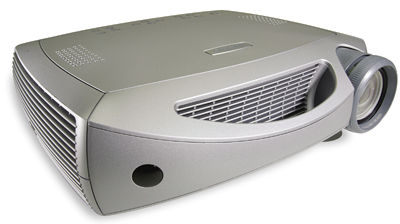InFocus ScreenPlay 7200 DLP Projector
18.1 foot-lamberts. This light output would be impressive for any front projector. What makes it amazing is that I measured 18.1 ft-L on a 7.5-foot-wide (100-inch-diagonal) Grayhawk screen with a 0.9 gain. If you were to use this projector on a 6-foot-wide (82.5-inch-diagonal) Studiotek 130 screen (which has a gain of +1.3), you'd get an almost-blinding 48.6 ft-L. With that kind of light output, you'd be able to use a screen larger than 12 feet wide (165 inches diagonally) and still have a bright, watchable image. And that's in the low-power mode.

The InFocus ScreenPlay 7200 has a sleek cabinet that won't win any beauty contests, but it doesn't make you cringe when you look at it, either. On the back are two sets of component and S-video inputs and single composite, VGA, and DVI (with HDCP) inputs. If you have a piece of equipment that uses a D5 connector, there's even a D5 input. You can disable any inputs you don't use in the user menu so that you don't have to cycle through them on your way to the active inputs. This is an excellent feature that I wish more products had. There are also two 12-volt triggers and a serial cable for setup.
You can mount the projector on the ceiling or, like I did, on a table. If you do the latter, two of the 7200's three feet are adjustable for height and leveling. The manual includes a useful chart that helps you figure out how far away from the screen you should place the projector. The 7200 has a manual zoom control to aid in placement and a manual focus ring so that you can (wait for it) focus the projector. While the manual focus ring isn't as easy to use as motorized focus, it is precise. Recruit an assistant to twist the ring while you look for the little dot in the center of each mirror. That way you'll know it's focused. If you have less-than-ideal placement, the keystone correction works surprisingly well.
The remote looks like a squashed egg, but it lies comfortably in your hand. The buttons are backlit, but the text that describes their functions isn't. If you can remember what the button with the squiggly line between two straight lines does, you're all set. Otherwise, you'll need to hold the remote into the projector's light path. The two most useful buttons are labeled resize and blank. The first adjusts the aspect ratio for any resolution, including HD. The second lights up the entire DLP array and puts a solid-blue (or white or black) image on the screen, which helps you position the projector, as you can see exactly where the panel ends. You can program the four discrete source buttons to any four inputs. The remote offers separate contrast and brightness controls, as well. These (and careful setup) are important, as it's easy to crush blacks on this and most DLPs. The remote's best feature is that you can point it in any direction, and it will work.

Like a jet's turbine, it takes a few seconds for the 7200 to really get going, but it's worth the wait. I have to say that there's something wildly addictive about watching a 100-inch-diagonal screen that's almost as bright as my last 27-inch TV. At this point, you can sort your way through the setup menu's many layers. You can adjust all of the normal video settings like contrast, color, brightness, and so on. There are also chroma and luma detail adjustments that let you adjust the amount of overall sharpness (edge enhancement) and the amount of color sharpness separately. The two most useful menu settings (and the two you're most likely to misuse) are gamma and color temperature. Out of the box, the 6500K setting is a little on the cool side, but it's close. The submenu contains RGB gain and bias controls. While these offer an appetizing amount of control, proceed with caution if you don't have equipment to measure the changes you're making. The ability to disable overscan is also a very cool feature. It allows you to adjust the picture slightly if your cable company or satellite provider adds white lines or other data junk to the visible picture area. Soundwise, audible noise hovers around 50 decibels next to the projector, which is good.
- Log in or register to post comments




































































